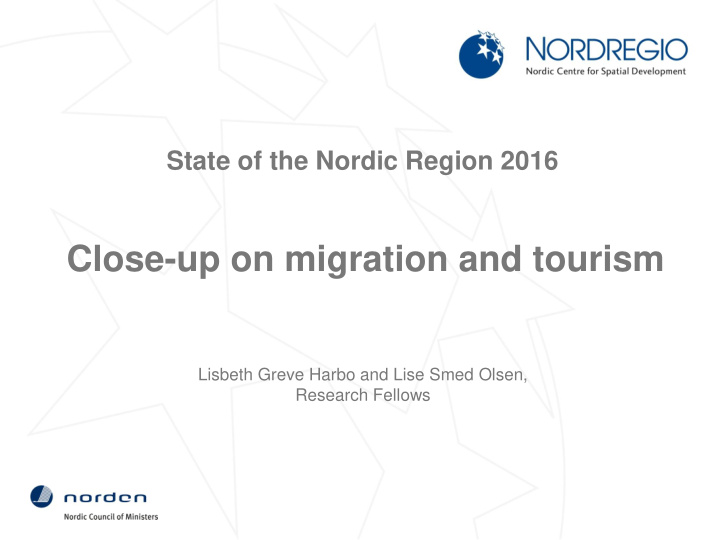



State of the Nordic Region 2016 Close-up on migration and tourism Lisbeth Greve Harbo and Lise Smed Olsen, Research Fellows
Migration terms Internal / international migration : migration between administrative levels and based on previous place of registration Immigration / emigration : national level In-migration / out-migration : regional / municipal level Net-migration : the difference between emigration and immigration or between in-migration and out-migration (+/-)
Migration has been the main component of population growth in the Nordic Region Natural 1990 2015 Total increase Net migration Total population 23.2 mio 26.5 mio 3.3 mio Population change (absolute ) 1.3 mio 2.0 mio Population change (percent) 14 % 5 % 9 %
Migration as the main component varies between the countries Population change, 1990-2015 (percent) Natural Total increase Net migration Norway 22,0 9,5 12,6 Sweden 14,3 3,9 10,4 Denmark 10,2 3,4 7,8 Åland 19,3 3,8 14,6 Greenland 0,8 22,9 -21,0 Faroe Islands 1,9 15,9 -13,9 Finland 10,0 5,2 4,6 Iceland 29,7 25,1 4,5
Migration patterns varies over time
Migration from where* varies over time From/To Denmark 2008 2011 2014 Nordic countries 804 1054 1970 BSR 11192 5954 6375 EU 6751 7862 11881 USA 474 1216 737 Syria 99 707 5420 Others 9939 5821 11082 *where being last country of registration rather than nationality
Migration patterns at regional and municipal level Clear pattern at regional level: Positive net-migration in Denmark, Sweden, Norway Out-migration from Greenland, Faroe Island and Iceland More complex at municipal level: General confirmation of the urbanisation process But also exemptions from this general trend
Importance of international net in-migration In absolute numbers, international immigration also concentrate in the metropolitan regions International immigration makes up for the internal out-migration from several peripheral and rural municipalities - without which they would be marked by even higher rates of depopulation
Role of in-migration at local and regional level Maintain / increase population – Maintain/increase municipal/regional transfers – Maintain services for the good of the whole population – Potential for new opportunities on the local labour market? Meet local demands for labour – Need for specialised employees – Unable to attract internal labour – Important local sectors with demand for international employees. One of these is tourism where we in some local labour markets see a significant • number of foreign employees
Changes in overnight stays 2008-2014 Highest growth in Iceland from 62% in Vesturland to 176% in Suðurnes Sweden: -9% in Dalarna / more than 20% increase in Stockholm and Kronoberg Finland : -13% in Kanta-Häme / 34% increase in Etelä-Karjala Åland : -14% Denmark : -9% in Nordjylland and Sjælland / 29% increase in Hovedstaden Greenland : -11% Norway : -47% in Sogn og Fjordane / 14% increase in Østfold
Total number of overnight stays in 2014 Concentration to capitals and other urban regions, the coastlines of DK and NO, Arctic destinations of FI and SE Domestic overnight stays form the majority in most regions – Iceland is the exception
Overnight stays by foreign citizens in 2014 Particularly in the Faroe Islands the share of overnight stays by other Nordic nationals is high (72% in 2014) A high share of German nationals in DK and South SE A high share of Russian nationals in FI A more varied mix of nationalities is evident in Iceland, Finnish Lapland, Norway, and in the capital regions
Economic impact of tourism Tourism Satellite Accounts: a standard statistical framework Inbound tourism expenditure as a percentage of GDP: – Increasing impact in Iceland from 4.5% in 2009 to 7.4% in 2013 – above the OECD average of 4.7% (2012) – Steady impact in the other Nordic countries • 1.3% in NO, 1.9% in DK, 2.1% in FI, 2.5% in SE (2013) The regional economic impact of tourism is not uniformly documented across the Nordic Region
Recommend
More recommend